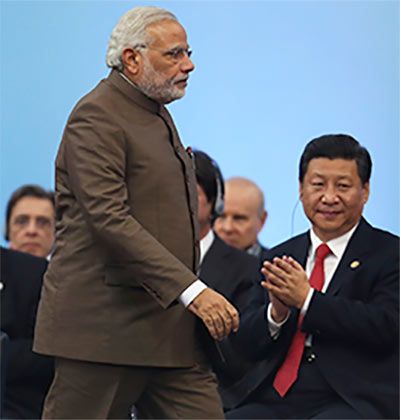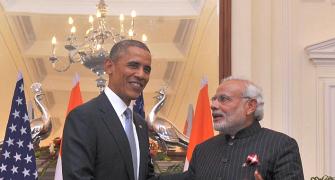 Making it easier to do business is a key element of our strategy, says Foreign Secretary S Jaishankar.
Making it easier to do business is a key element of our strategy, says Foreign Secretary S Jaishankar.
The connection between business and diplomacy is self-evident. Indeed, business has driven national and group strategies virtually over the entire course of human history. The issue, therefore, is less about correlation and more of the extent of centrality of business to the formulation of strategy.
Indian experience since independence reveals that the growing salience of business at home is reflected abroad as well. An era of greater State control and direction obviously had its own particular brand of diplomacy.
With changing times and higher growth, a new mindset gradually came into place. There is a sharper realisation that the real strengths of any nation are primarily economic. That, in turn, has led to a growing recognition that business provides the ballast for many of our important international relationships. ASEAN, the Gulf, the US and China are examples. It is the primary driver in some, perhaps a little less salient in others, but never entirely absent.
In contentious situations, business can even serve as a mitigating factor. Where strategic imperatives are less pronounced -- in Europe, Latin America and parts of Africa -- business is actually our main connect. As we now look beyond narrower economic reform towards a much broader modernisation effort, its relevance to our engagement with the world is only stronger.
India’s approach in aligning business and strategic goals bears some similarity to the experiences of East Asian and South East Asian polities as they traversed their path of national development. Increasingly, our foreign policy is dominated by the quest for capital, resources, technology, capabilities and best practices. They have become the benchmarks to judge the success or otherwise of policies and interactions.
It is telling that considerable efforts are invested to encourage the involvement of external partners in development programmes like Digital India, Skill India, SmartCities or Namami Gange. When a prime minister goes to Hannover to showcase ‘Make in India’ or to San Francisco to unveil ‘Start Up India’, clearly we are entering a different era. It is one where making it easier to do business is a key element of our strategy.
Today, every embassy has a designated commercial officer. We are the first port of call not just for Indian business going out, but increasingly for foreign business coming in. There is a division in the foreign ministry tasked to hand-hold foreign investors. Creating a better enabling environment for business is our daily mantra. And addressing the political and regulatory impediments is very much at the heart of our diplomatic agenda.
This is a very different foreign service from the one I joined four decades ago.
Underlying the endeavour to align business and strategic goals is our shifting understanding of the world itself. A period of extraordinary change began with the end of the Cold War and the economic rise of Asia. It was further underlined by the 2008 crisis that brought out the redistribution of power in the global order.
But perhaps even more impactful are the daily consequences of multiple technology revolutions. To a country like India, they offer enormous leap-frogging possibilities.
It is not just the power hierarchy that is changing. The actual interplay of nation-States is clearly circumscribed by interdependence. The global strategic landscape, in fact, looks increasingly like a business environment. Its key concepts are risk assessments, convergence, margins, competition, leveraging and hedging. Different partners, some with competing interests, often have to be simultaneously engaged.
If operations have become more nuanced, challenges in international politics too are more blurred. Nothing is absolute anymore. Those who can comprehend this changing paradigm will get ahead. Conversely, those who cannot are destined to be trapped in old debates.
With this background, it is useful to evaluate how India’s capabilities and requirements will impinge on its global strategy. Let me begin with resources, in our case the most important of them being the human one. Whether India really reaps the demographic dividend or not depends on our economic growth, the expansion of manufacturing, the success of skilling initiatives and the spread of education, literacy and health.
Clearly, these are policy outcomes and not a foregone conclusion. But as prospects improve, we must assess the importance of the availability and accessibility of human resources to an ageing world. While they may have political and social repercussions, the economic logic of changing production and skills centres is hard to ignore. Global trade discussions cannot indefinitely frontload goods and investments at the cost of services and labour mobility.
Then, there is the question of how we see the implications of expanding manufacturing at home. Make in India is not make for India. While we may legitimately exploit our domestic market advantages, the real game is to integrate more deeply into the global supply chain and gain better market access abroad. Indeed, striking an optimal balance between these competing factors is at the heart of our trade strategy.
In so far as our resource dependence is concerned, probably the one most worthy of strategising is that relating to energy. Not coincidentally, it is also the domain that has seen the greatest activism in our recent diplomatic interactions. Where fossil fuel is concerned, one objective is to obtain assured upstream access in producing economies like Russia, Iran, UAE, Qatar, Mexico or Saudi Arabia. Another is to secure greater investments in downstream areas.
But with the world moving towards greener and cleaner energy, and given our own commitment to shift to 40 per cent non-fossil power generation capacity by 2030, attention is increasingly shifting to renewables. Our solar energy programme has been exceptionally ambitious and gotten off to a flying start. The International Solar Alliance initiative reflects this priority.
It is, however, nuclear energy that will constitute the core of this commitment and is, therefore, central to India’s approach to climate change. In that regard, we are in a position now to build on the international cooperation openings that have been negotiated in the last decade and confirmed by the settlement of the liability issue.
The path is once again open to a substantial increase in domestically produced nuclear power plants while simultaneously moving forward with foreign partners. These large anticipated investments in the nuclear energy sector can, however, only happen in a climate of predictability. In particular, it would require greater certainty of trading rules and technology access.
It is our expectation that membership of the Nuclear Suppliers Group can effectively address that concern. A stronger Indian nuclear industry can help make nuclear power more competitive globally. Indeed, as our own nuclear industry expands and we go rapidly beyond the 140 nuclear-related export licences that we issued last year, it is also in larger interest that our practices are in conformity with global ones.
If assured energy is one critical enabler to sustain and accelerate growth, then better connectivity and a modern infrastructure is the second.
Considerable diplomatic energies are consequently devoted to this objective where international partnerships can make all the difference. They build on infrastructure initiatives already underway like the Delhi-Mumbai Industrial Corridor but also on more liberal FDI policies recently put in place for key sectors like railways, ports, roads and highways.
There has been progress across a broad front with some changes already visible on the ground, others moving out of the drawing board and still more in different stages of the pipeline. Japan has been a particularly valued partner in this context but China, some ASEAN members, Europe and the US are also coming into play in its many dimensions.
These infrastructure developments will certainly have geo-political repercussions. At the minimum, they would accelerate the global economic rebalancing by helping provide the foundation for India’s manufacturing ambitions. But they would also correct historical imbalances, in particular, by developing our eastern coast that was so neglected during the colonial period.
In the ministry of external affairs, we have a particular responsibility towards the conceptualisation and execution of connectivity projects relating to our immediate neighbours. Assessing the progress that we are making, I can predict with some confidence that regional connectivity will advance substantially even in the next few years. So too will our access to the extended neighbourhood.
Projects underway in Bangladesh and Myanmar will strengthen our Act East capabilities. On the West, the Chabahar port and other Iranian-centred international transit initiatives will give us better access not just to Afghanistan but Central Asia, Russia and even Europe. Our encouragement to business stepping forward is obviously not oblivious to a strategic logic.
A related issue is strengthening the ability of Indian businesses to effectively compete abroad. We cannot be impervious to the global trend of batting for your business. Whether it is facilitating credit or access, undertaking networking or advocacy, this is increasingly a legitimate expectation that business has of the government.
Building a Team India culture within and beyond the officialdom is very much a part of this thinking. That the foreign ministry today has specific divisions to focus on lines of credit, training and projects abroad underlines this more strategic view of business.
While the reordering of the global system reflects opportunities that have been seized, they also come with their own burdens and responsibilities. It is evident that ensuring the security of the global commons and responding to its many challenges will increasingly have to be a shared endeavour.
By virtue of its location, reflecting ties of kinship and culture, and taking into account its growing commerce, India has a particular obligation in respect to the oceans in the south. We are responding vigorously and effectively through a more integrated strategy. Examples include white shipping agreements, coastal surveillance, hydrographic surveys, HADR operations and naval exercises. Indeed, it is this domain that most expressively demonstrates the alignment that we are discussing.
Of all the global challenges, none has captured the world’s attention more than that of the threat of terrorism. Whether it is its orthodox version that this city knows only too well, or the more recent cyber manifestations, the intention remains one of dominating through disruption.
National resilience and systemic hardening are obviously part of the answer. But equally important are pre-emptive and responsive policies. International cooperation in that regard has consequently come to occupy a significant place in our diplomatic agenda. While this is a subject in itself, let me just state that events have shown that a reputational downgrade is as damaging for nations as for companies.
To sum up, a comparison of statements and outcomes of Indian diplomacy over the last many decades will bring out how much more central economic and developmental issues have become to our external engagements.
No high-level visit is complete today without a business event. Ensuring market access and responding to investor concerns are taken as a given. The advancement of flagship programmes is clearly a key thrust. Enhancing national branding is a major preoccupation. Most important, a more global business outreach has widened the horizons of Indian diplomacy.
A new normal is in the making, one where the business of Indian diplomacy is increasingly business.
Excerpted from Foreign Secretary S Jaishankar’s keynote address at the first Gateway of India Dialogue conference in Mumbai, organised in association with the ministry of external affairs, on June 13, 2016.









